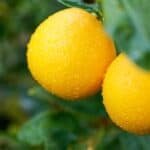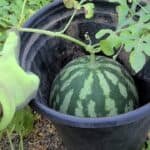To determine if jujubes are ripe, look for the following indicators:
- Color: Jujubes should be completely dark brown when fully ripe. However, they can be consumed when they are only approximately 50% brown and green everywhere else.
- Texture: The fruit should feel firm to the touch when consumed fresh and will begin to lose moisture soon after the skin of the fruit has turned completely brown while still on the tree.
- Storage: Fresh jujubes are best stored between 52°F and 55°F in a special green plastic bag that counters the ethylene gas naturally given off by ripe fruit.
- Drying: Jujubes can also be allowed to fully dry on the tree or picked when they just begin to show signs of desiccation (wrinkled skin).
- Cutting the stem: Instead of pulling the fruit off the tree, cut the small stem to give you a clean sealed product.
Jujubes are ripe when they are completely dark brown and have a firm texture.
They can be consumed at different stages of ripeness, but the best time to harvest is when they are fully brown and impart a dry pear-apple-like flavor.
How to store jujubes after they are ripe
To store jujubes after they are ripe, follow these steps:
- Refrigeration: Fresh, ripe jujubes can be stored in the refrigerator for up to a week, but they taste best when consumed directly after purchase.
- Airtight container: Place the jujubes in an airtight container to keep them fresh.
- Freezing: If you want to extend the storage life of jujubes, you can freeze them for a few hours, then remove them from the freezer and allow the excess condensation to evaporate before placing them in the storage container.
- Drying: If you prefer to store jujubes in their dried form, you can allow them to fully dry on the tree or pick them when they just begin to show signs of desiccation (wrinkled skin).
- Controlled atmosphere storage: For a longer storage period, you can use controlled atmosphere storage, which involves storing the jujubes in a low-oxygen environment at low temperatures to inhibit ripening and aging.
- Hypobaric storage: Another option for long-term storage is hypobaric storage, which provides low-temperature, low-oxygen storage conditions to delay ripening and aging.
Remember to check the jujubes regularly for signs of spoilage and discard any that show signs of mold or softness.
What are some recipes that use ripe jujubes?
Here are some:
- Jujube Butter Oatmeal Bars: This recipe involves simmering jujubes with apple cider to make a fruit butter, which is then used to create a delicious oatmeal bar cookie.
- Jujube Cake: A favorite recipe from Rancho La Puerta, this cake uses ripe or dried jujubes, along with lemon zest and vanilla extract.
- Savory Jujube Dessert Topping: This topping is made by cooking jujubes with brandy, raw sugar, honey, and other ingredients, then blending it to a smooth consistency.
- Jujube Fruit and King Oyster Mushroom Sauté: This dish combines jujubes with king oyster mushrooms, creating a unique and flavorful meal.
- Jujube Rice Pudding: This gluten-free recipe uses jujube fruits in place of raisins, along with arborio rice and milk.
- Jujube Tea: Jujubes can be steeped in hot water to create a warming tea, which is traditionally enjoyed in Southeast Asia.
- Jujube Syrup: Jujubes can be used to make a sweet syrup, which can be used as a topping or in various desserts.
Remember to check the ripeness of the jujubes before using them in these recipes. Ripe jujubes should be completely dark brown and have a firm texture.
Was this article helpful?
YesNo


![How to Determine if Garlic is Ripe: A Comprehensive Guide [Steps] Woman in a garden holding freshly harvested garlic, smiling and explaining how to determine when garlic is ready to harvest. Text overlay asks, "When is garlic ready to harvest?"](https://ostrali.com/wp-content/uploads/2024/02/dp5fMGNEW9I-150x150.jpg)
![How to Tell If a Mango is Ripe and Sweet: The Ultimate Guide [Steps] Two yellow mangoes on a wooden surface, one firm and unripe, the other soft and overripe, with text discussing ripeness and discard advice.](https://ostrali.com/wp-content/uploads/2024/02/RCg9BOqPh1U-150x150.jpg)








